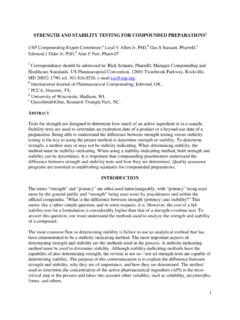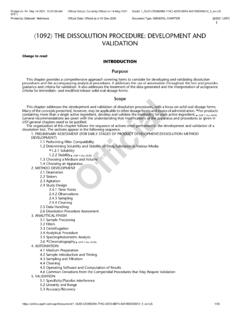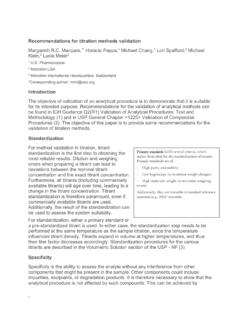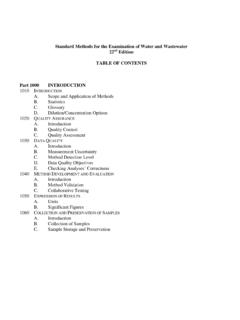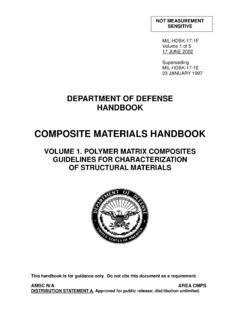Transcription of ALKALINE DUSTS 7401
1 ALKALINE DUSTS 7401. NaOH, KOH, LiOH, MW : (NaOH); CAS: 1310-73-2 RTECS: WB490000. (NaOH). and basic salts (KOH) 1310-58-3 TT2100000 (KOH). (LiOH) 1310-65-2 OJ6307070 (LiOH). METHOD: 7401, Issue 2 EVALUATION: FULL Issue 1: 15 February 1984. Issue 2: 15 August 1994. OSHA : 2 mg/m 3 (NaOH) PROPERTIES: basic, hygroscopic, caustic solids and NIOSH: C 2 mg/m 3/15 min (NaOH); Group I Pesticide aerosols; VP not significant ACGIH: C 2 mg/m 3 (NaOH). SYNONYMS: alkali; caustic soda; lye; sodium hydroxide; potassium hydroxide SAMPLING MEASUREMENT. SAMPLER: FILTER TECHNIQUE: ACID-BASE TITRATION. (1- m PTFE membrane).
2 ANALYTE: OH - (alkalinity). FLOW RATE: 1 to 4 L/min EXTRACTION: mL N HCl, 15 min under VOL-MIN: 70 L @ 2 mg/m 3 nitrogen with stirring -MAX: 1000 L. TITRATION: N NaOH under nitrogen, endpoint SHIPMENT: routine by pH electrode SAMPLE CALIBRATION: N NaOH standardized with STABILITY: at least 7 days @ 25 C [1,2] N HCl BLANKS: 2 to 10 field blanks per set RANGE: to mg (as NaOH) per sample [1]. ESTIMATED LOD: mg per sample (as NaOH) [1]. (7 x 10 -4 moles of alkalinity). ACCURACY PRECISION (Sr): @ to mg NaOH. per sample [1]. RANGE STUDIED: to mg/m 3 [1]. (360-L samples). BIAS: ): [1]. OVERALL PRECISION (SrT.
3 ACCURACY: APPLICABILITY: The working range is to mg/m 3 for a 360-L air sample. The method measures total alkalinity of alkali hydroxides, carbonates, borates, silicates, phosphates, and other basic salts, expressed as equivalents of NaOH. INTERFERENCES: Carbon dioxide in the air may react with alkali on the filter to produce carbonates but does not interfere when titrated. The carbonates will produce the equivalent amount of strong alkali that was consumed on the filter [1]. Acid a erosols may neutralize the sample, if present, producing a negative interference. OTHER methods : This revises methods S381 [2] and P&CAM 241 [3].
4 NIOSH Manual of Analytical methods (NMAM), Fourth Edition, 8/15/94. ALKALINE DUSTS : METHOD 7401, Issue 2, dated 15 August 1994 - Page 2 of 4. REAGENTS: EQUIPMENT: 1. Sodium carbonate, primary standard grade. 1. Sampler: 37-mm diameter PTFE membrane 2. Hydrochloric acid stock solution, N. filter (Millipore, Fluoropore or equivalent), Standardize with sodium carbonate primary m pore size, supported by a cellulose backup standard. pad in a cassette filter holder. 3. Dilute hydrochloric acid, N. Dilute 2. Personal sampling pump, 1 to 4 L/min, with mL N stock HCl to 100 mL in a volumetric flexible connecting tubing.
5 Flask with distilled water. 3. pH meter with pH electrode and recorder. 4. Water, distilled, CO 2-free. Boil and cool under 4. Titration vessel, 150 to 200 mL beaker, flask N2 or bubble nitrogen through distilled water or jar with cover containing openings for the for 30 min. Store with an Ascarite trap. pH electrode and N 2 inlet and outlet. 5. Nitrogen, compressed. 5. Stirrer, magnetic, and stir bar. 6. Sodium hydroxide, 50% w/v.* Dissolve 50 g 6. Glass rod, ca. 5-mm diameter and 10 cm long NaOH in CO 2-free distilled water and dilute to to hold filter under liquid surface in titration 100 mL.
6 Vessel. 7. Stock sodium hydroxide, N. Dilute 8 mL 7. Pipets, 5- and 10-mL. 50% NaOH to L with CO 2-free distilled 8. Volumetric flasks, 100-mL and 1-L. water. Store under Ascarite or other CO 2- 9. Burets, 50-mL, readable to mL. absorbing trap. 10. Tweezers. 8. Working sodium hydroxide solution, N. Dilute 10 mL stock ( N NaOH) to 100 mL. with CO 2-free distilled water. 9. Standard buffer solutions, pH 4 and 7. * See Special Precautions SPECIAL PRECAUTIONS: NaOH solutions are corrosive to tissue [4]. Handle with care. SAMPLING: 1. Calibrate each personal sampling pump with a representative sampler in line.
7 2. Sample at an accurately known flow rate between 1 and 4 L/min for a sample size of 70 to 1000. L. Do not exceed a filter loading of ca. 2 mg total dust . SAMPLE PREPARATION: 3. Transfer the sample filter to a titration vessel with tweezers. Place the filter face down in the titration vessel. 4. Place the end of a glass rod in the center of the filter to maintain the filter below the liquid surface during the analysis. 5. Cover the titration vessel, add mL N HCl, start the magnetic stirrer and N 2 purge (ca. L/min). 6. Allow to stand 15 min (with stirring). CALIBRATION AND QUALITY CONTROL: 7.
8 Calibrate the pH meter with pH 4 and pH 7 buffer solutions. 8. Standardize aliquots of the N HCl stock solution with sodium carbonate in triplicate [3]. a. Dry 3 to 5 g primary standard grade Na 2CO 3 at 250 C for 4 h. Cool in a desiccator. b. Weigh ca. g Na 2CO 3 to the nearest mg. Dissolve and dilute to exactly 1 L with CO 2-free distilled water. The concentration is ca. N Na 2CO 3. c. Place mL N Na 2CO 3 solution into a titration vessel and titrate potentiometrically to a pH of 5. NIOSH Manual of Analytical methods (NMAM), Fourth Edition, 8/15/94. ALKALINE DUSTS : METHOD 7401, Issue 2, dated 15 August 1994 - Page 3 of 4.
9 D. Remove electrodes, rinse them into the titration vessel, and bubble N 2 gas through contents of the titration vessel for 3 to 5 min to remove dissolved CO 2. e. Proceed with the titration to the inflection point. f. Calculate the normality of the stock HCl solution: 9. Standardize the working (ca. N) NaOH solution against the standardized HCl solution by following steps and , substituting the standardized HCl stock solution for the Na 2CO 3. solution and the N NaOH solution for the N HCl solution. Calculate the normality of the NaOH titrating solution. NNaOH = (N HCl)(mL HCl used)/(mL NaOH used).
10 10. Prepare at least three spiked media blank samples to check analytical recoveries at levels expected on the field samples. MEASUREMENT: 11. Back-titrate the excess HCl in the samples, blanks and spiked blank solutions with the standardized NaOH solution while maintaining the N 2 purge. 12. Observe the pH meter. Calculate the endpoint (mL of N NaOH used). CALCULATIONS: 13. Using the normality (N) and volumes of NaOH in the titration of the sample (V NaOH-s ) and average blank filter (V NaOH-b ), and the volume of air sampled, V(L), calculate the concentration, C (mg/m 3), of alkalinity (as NaOH with equivalent weight = ): EVALUATION OF METHOD: Method S381 [1] was issued on July 8, 1977, and was validated using generated atmospheres of NaOH.










